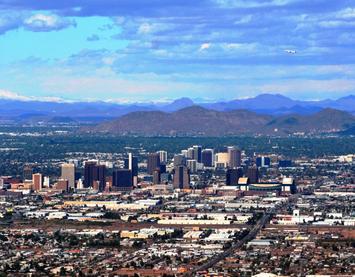
The Phoenix city council is considering delaying or even killing some planned light-rail lines because it is concerned that city streets are falling apart and too much money is being spent instead on an insignificant form of travel. The council considered but rejected a similar proposal a couple of months ago, but since then two councilors who opposed the proposal have been replaced and at least one of them is inclined to favor streets over rails.
As of 2016, light rail carries less than 0.2 percent of all travel in the Phoenix urban area. The 2016 American Community Survey says that the same tiny percentage of commuters take light rail to work, which is unusual as transit’s commuter share is usually much higher than its total share. Phoenix light-rail ridership in the twelve months ending in June, 2018 was down 4.4 percent from the previous twelve months. Transit ridership for Phoenix as a whole is down 5.6 percent for the same time period.
Phoenix is one of many Sunbelt urban areas in which rail transit makes no sense at all. Aside from the Antiplanner’s argument that buses can move more people than light rail, rail systems only make sense where there is a high concentration of downtown jobs that a hub-and-spoke transit system can serve. According to Wendell Cox’s calculations, downtown Phoenix has only about 26,000 jobs, which is just 1.4 percent of jobs in the metropolitan area.
Phoenix is particularly unusual (though not unique) in that its suburbs are actually denser than the city itself. According to the 2010 census, the city of Phoenix has about 2,800 people per square mile, while its suburbs have nearly 3,500 people per square mile. With both jobs and population spread out, the region needs nimble, low-capacity transit if it needs any transit at all.
Arizona State University students make up a “substantial component” of light-rail riders. Until this year, students were able to buy transit passes for $200 for the nine-month school year, plus $75 for the other three months. The same passes would cost other members of the public $768 per year. Despite the steep discounts, student weekday ridership dropped by around 40 percent between 2011 and 2015.
In July, the university and transit agency announced that the price of the nine-month pass would be reduced by 25 percent to $150. They claimed the reduction was made to promote “sustainable transportation,” but it is more likely that it was an effort to recover some of those lost riders. I suspect that this effort will fail, and even if it works a little, what good are riders who don’t have to pay much for their rides?
Light rail is a losing proposition for Phoenix, and the city council would be wise to stop all new construction.
This piece first appeared on The Antiplanner.
Randal O’Toole is a senior fellow with the Cato Institute specializing in land use and transportation policy. He has written several books demonstrating the futility of government planning. Prior to working for Cato, he taught environmental economics at Yale, UC Berkeley, and Utah State University.
Photo by DGustafson [Public domain], from Wikimedia Commons












